
- iOS开发之ReactiveCocoa下的MVVM(干货分享)
- IOSNSNotificationCenter通知中心的使用
- iOS各种调试技巧豪华套餐
- iOS学习笔记(6)键值编码——KVC
- 3D-TouchHomeScreenQuickActions使用
- iOS应用中发送HTTP的get请求以及HTTP异步请求的方法
- iOS开发日记8-MD5加密
- 如何实现IOS_SearchBar搜索栏及关键字高亮
- ASIHTTPRequest
- IOSinfo.plist配置文件
- iOS开发中创建对象的两个方法对比
- OC基础--对成员变量的封装
- iOS开发-在哪里更新customview的subviews的位置信息?(drawRect:还是layoutSubviews?)
- 【读书笔记】iOS-苹果的网络
- iOS开发之手势识别
- IOS开发之文件管理
- ios将Log日志重定向输出到文件中保存
- UITableViewCell高度计算从混沌初始到天地交泰
- IOS自制类似于下拉框的控件
- 2015年iOS测试现状
- Cornerstone--SVN项目管理工具简易教程
- IOSKey-ValueObserving(KVO)
- 教你写能被舒服舒服又舒服地调用的iOS库
- iosapp提交评审注意事项
- IOS开发代码分享之用nstimer实现倒计时功能
- Swift中的willSet与didSet
- ios开发--常用宏定义(部分转)
- Model-View-ViewModelforiOS[译]
- Objective-C知识总结(5)
- NSOperation
Instruments_ActivityMonitor使用入门
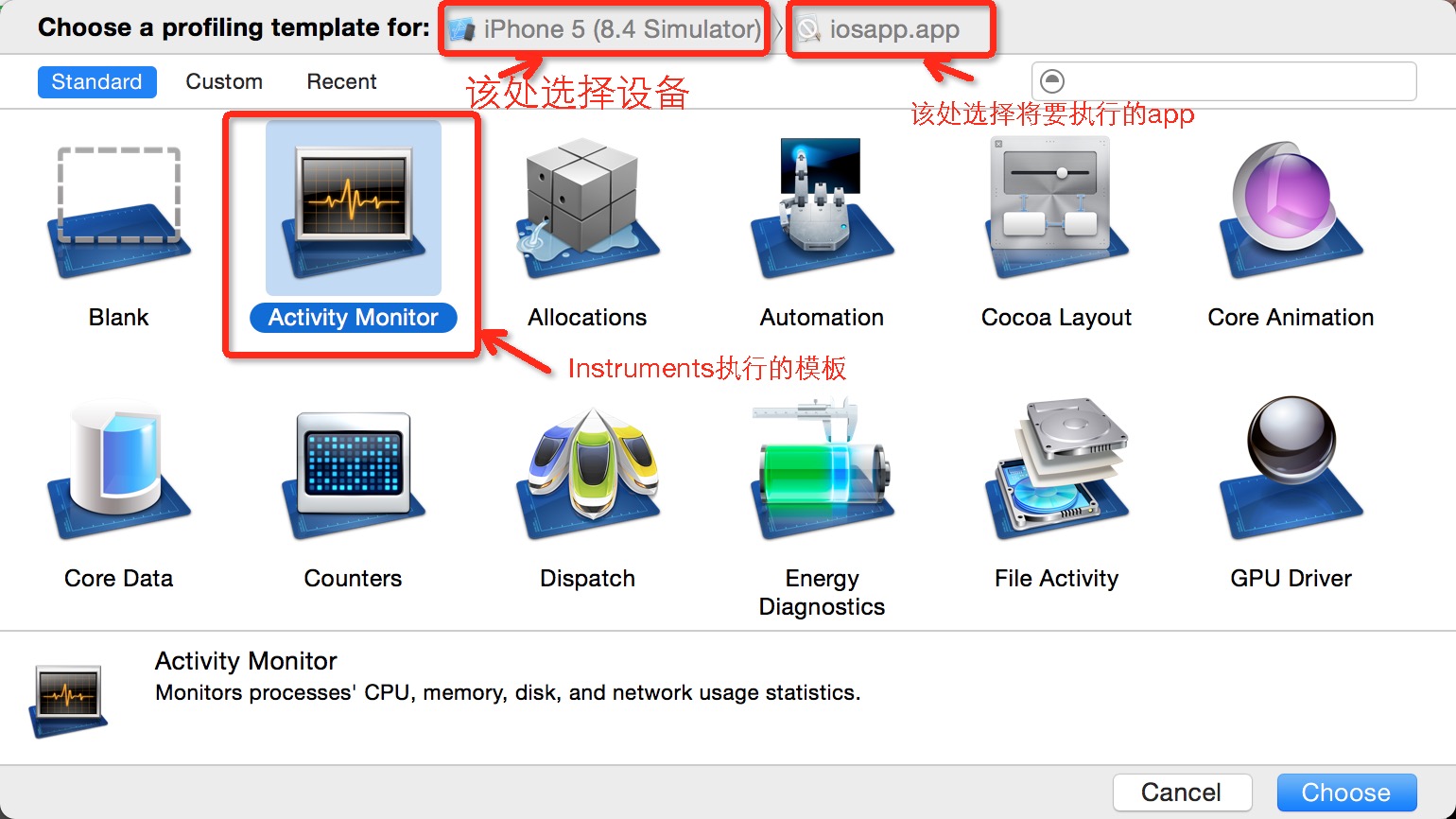
Activity Monitor打开之后是这个样子,所有都是空的
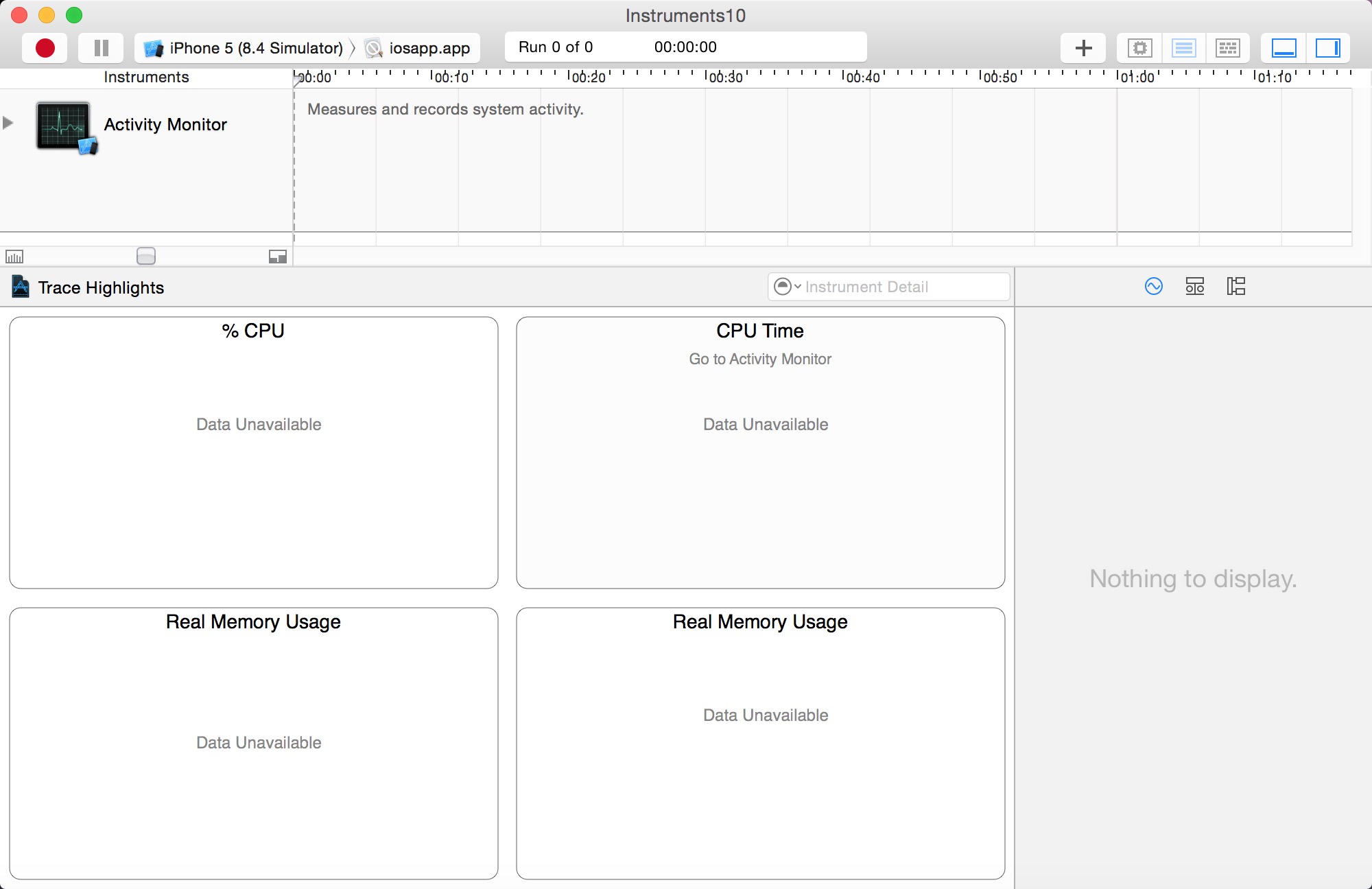 当运行的设备和运行的app都准备好了,我们开始运行Activity Monitor,点击左上角的红色圆点按钮,开始记录手机中CPU和内存的使用情况,得到下图:
当运行的设备和运行的app都准备好了,我们开始运行Activity Monitor,点击左上角的红色圆点按钮,开始记录手机中CPU和内存的使用情况,得到下图:
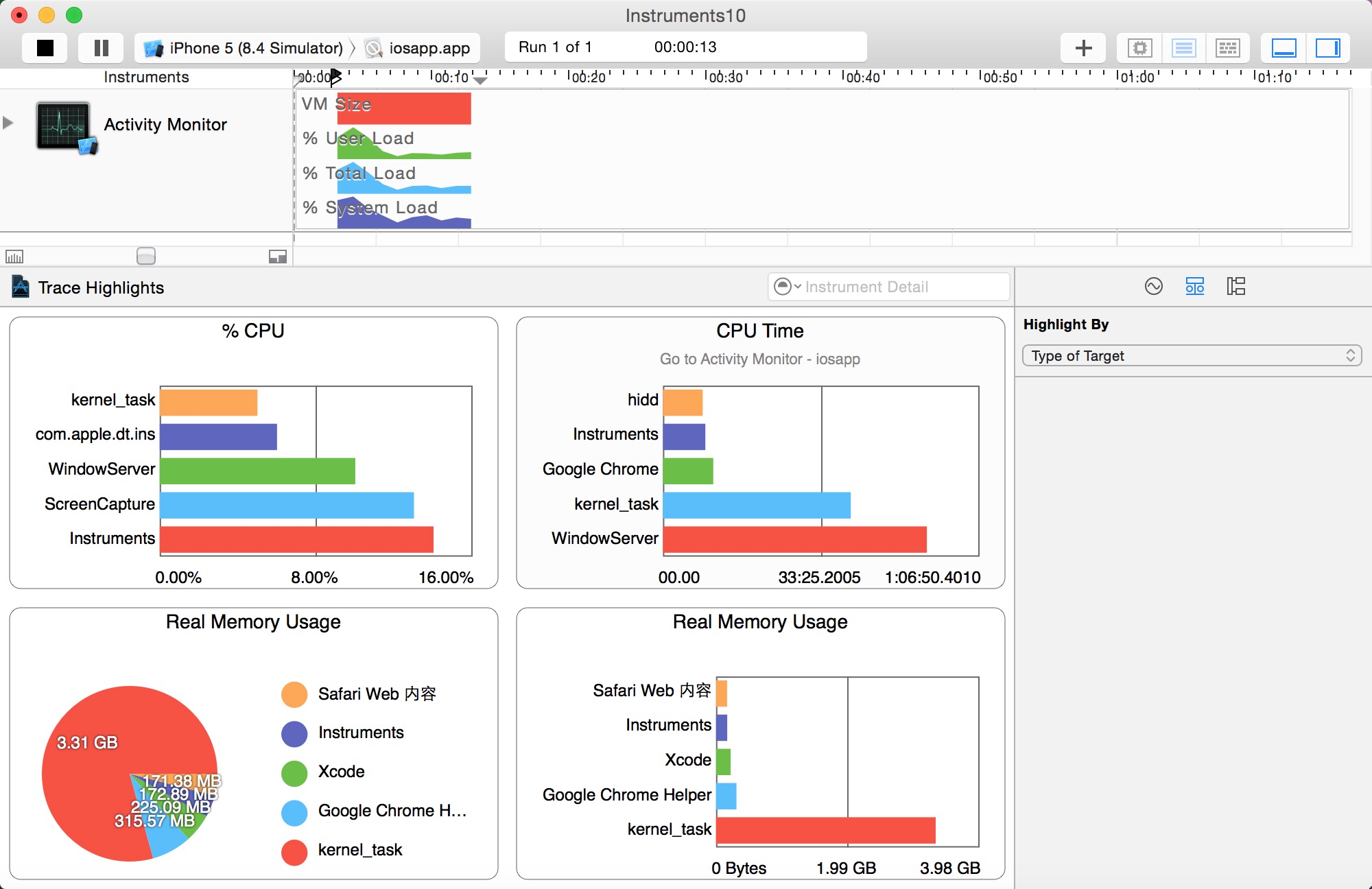 我们分析一下这些图的意思:
%CPU:不同进程对CPU的占比
CPU Time:CPU运行时间
Real Memory Usage:进程使用的内存量,用了饼状图和柱状图展示
上图只是这些数据的大概结果我们可以去查看具体的数据,点击上图4个任意自己想要查看信息的图片,分析的结果有4种分析结果【Summary、Parent Child、Samples、Console】,我们一个个来分析
(1)Summary(Summary of data) ---------Process(进程)使用内存、CPU使用时长等摘要信息
我们分析一下这些图的意思:
%CPU:不同进程对CPU的占比
CPU Time:CPU运行时间
Real Memory Usage:进程使用的内存量,用了饼状图和柱状图展示
上图只是这些数据的大概结果我们可以去查看具体的数据,点击上图4个任意自己想要查看信息的图片,分析的结果有4种分析结果【Summary、Parent Child、Samples、Console】,我们一个个来分析
(1)Summary(Summary of data) ---------Process(进程)使用内存、CPU使用时长等摘要信息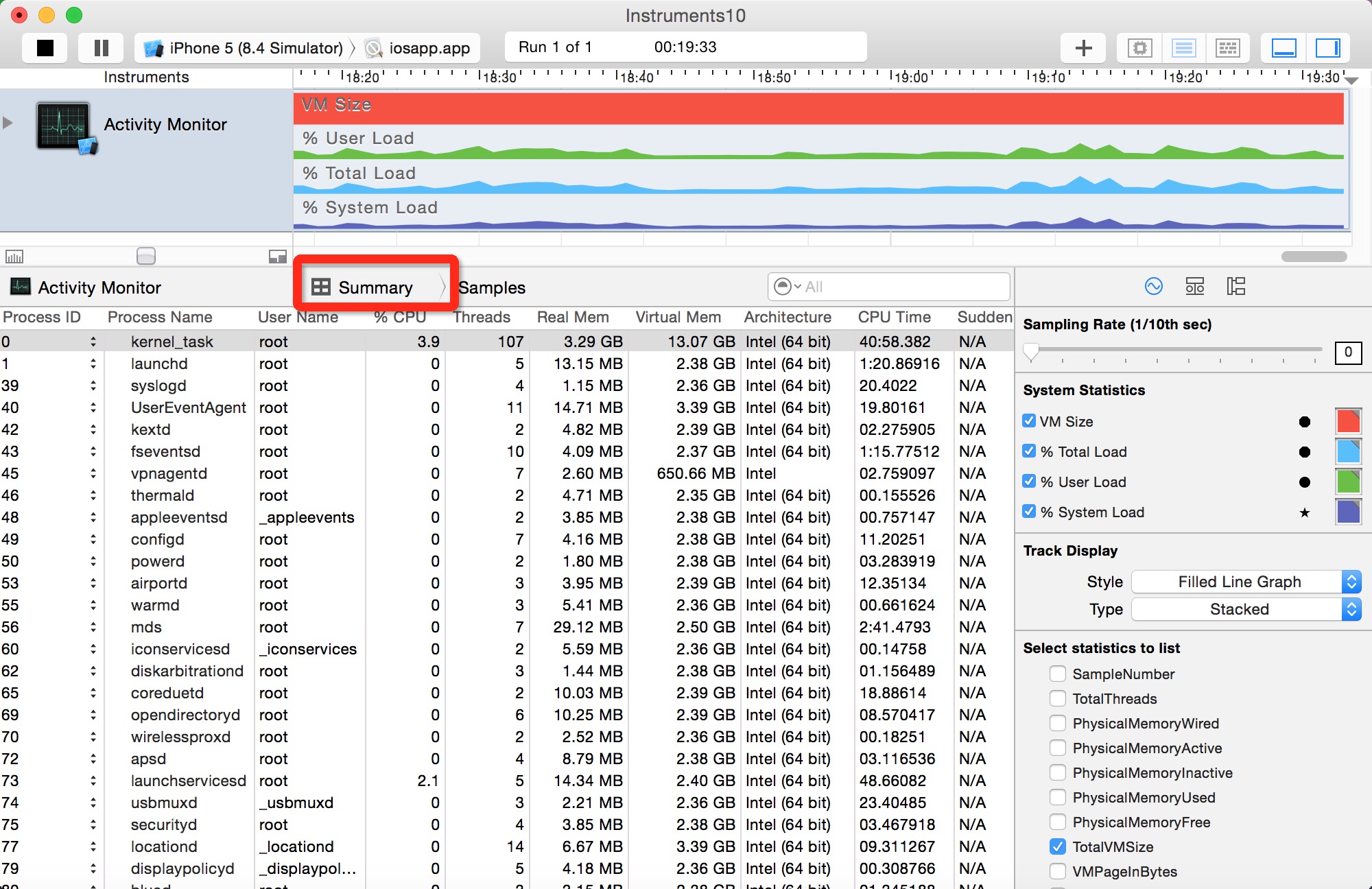 其中参数的含义如下:
process id ——进程id
process name ——进程名
user name——用户名
%CPU——cpu占比
threads——线程
real mem——真正使用的内存
virtual mem——虚拟内存
architecture——架构
cpu time——CPU时间
sudden term——突然项(N/A:不适用)
(2)Parent Child(
其中参数的含义如下:
process id ——进程id
process name ——进程名
user name——用户名
%CPU——cpu占比
threads——线程
real mem——真正使用的内存
virtual mem——虚拟内存
architecture——架构
cpu time——CPU时间
sudden term——突然项(N/A:不适用)
(2)Parent Child(
parent child information)-----父进程和子进程的关系,以及各个进程的概要信息
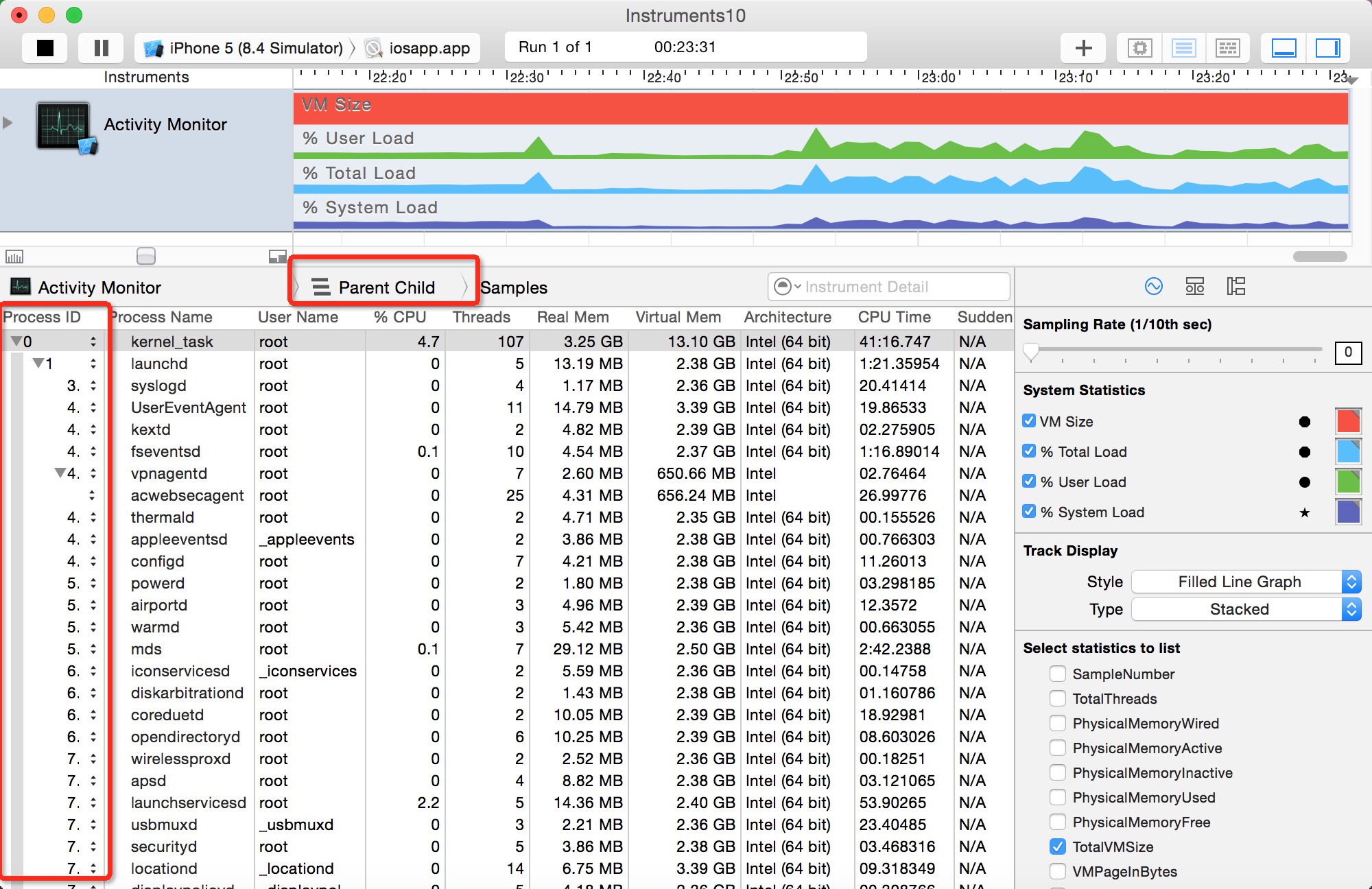 它的参数与Summary是一样的,内容也是一样的。但是它具有层级关系(即父子关系),子进程在父进程的下一层级。(父进程上,可以展开、关闭它的所有子进程)
(3)Samples(a list of samples) ----一系列抽样(即不同时间,CPU使用时间、内存使用情况的样本值)
它的参数与Summary是一样的,内容也是一样的。但是它具有层级关系(即父子关系),子进程在父进程的下一层级。(父进程上,可以展开、关闭它的所有子进程)
(3)Samples(a list of samples) ----一系列抽样(即不同时间,CPU使用时间、内存使用情况的样本值)
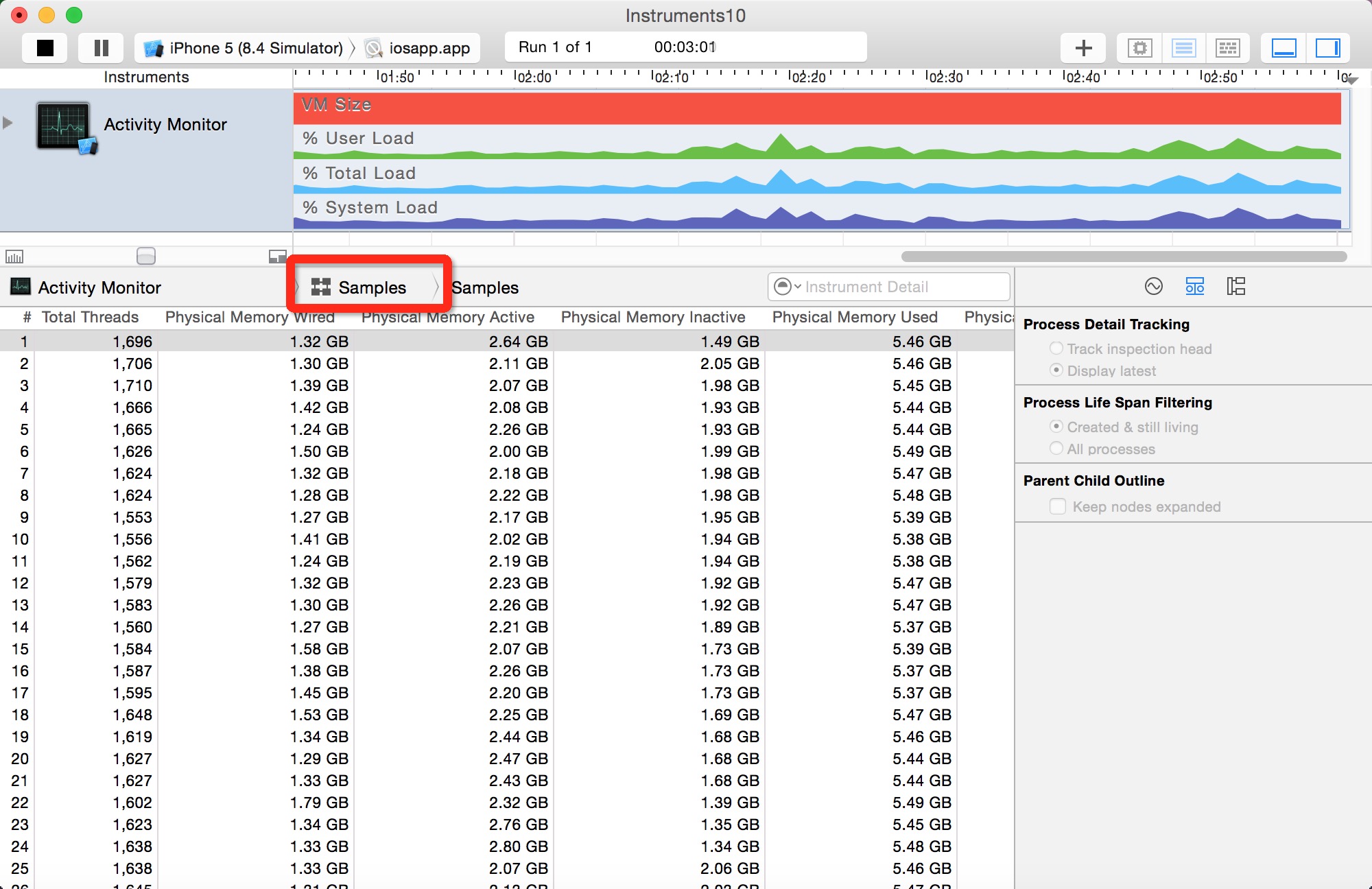 参数的含义如下:
参数的含义如下:
- Physical Memory Wired——操作系统占用的内存
- Physical Memory Active——除操作系统外其它进程占用的内存
- Physical Memory Inactive——最近被释放的内存
- Physical Memory Used——profiling当前进程时使用的总内存
- Physical Memory Free——当前的可用内存
- Total VM Size——虚拟内存的占用量
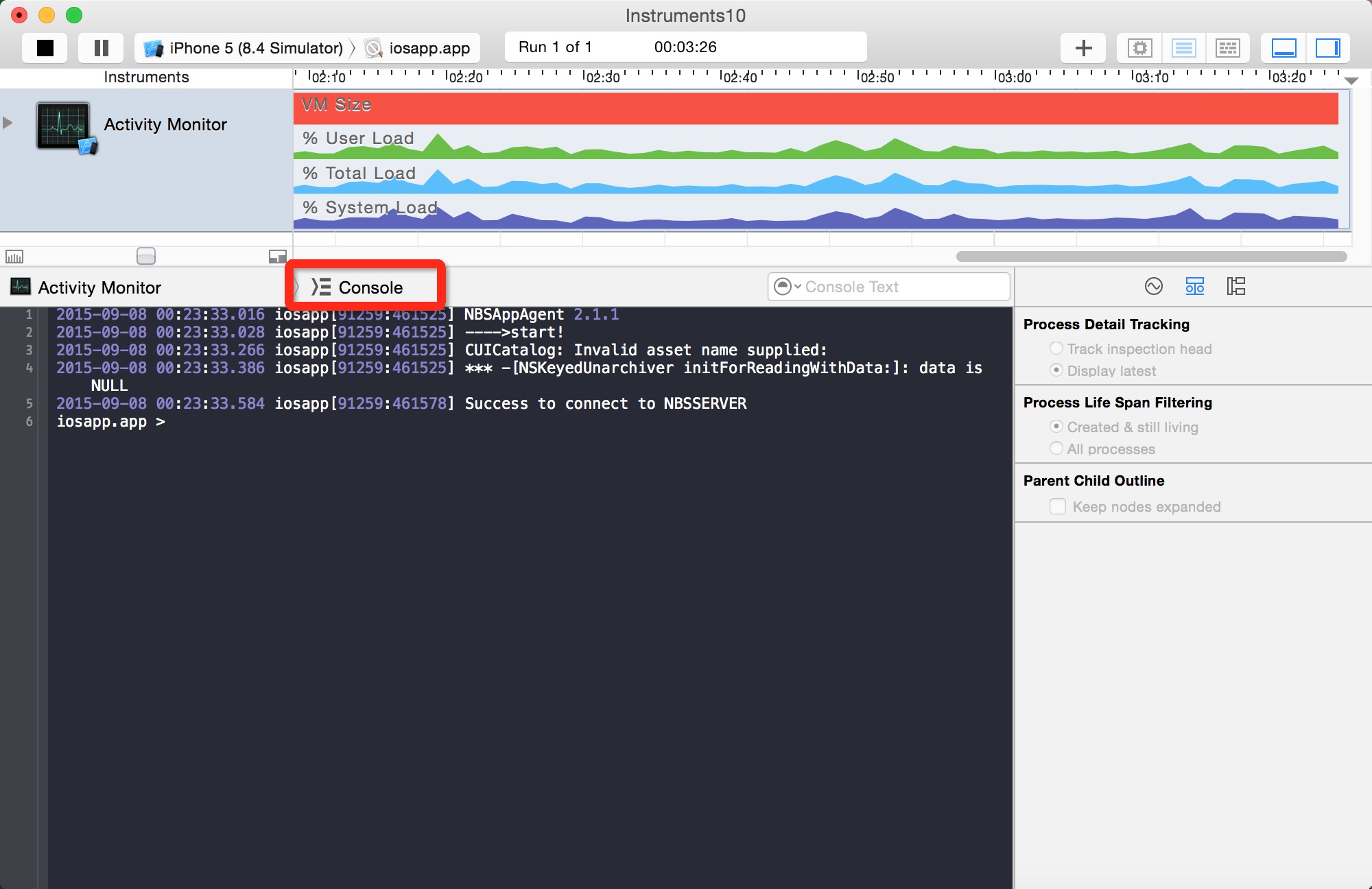 提示:
Activity Monitor默认配置了在Timeline面板中显示的内容,包括
提示:
Activity Monitor默认配置了在Timeline面板中显示的内容,包括TotalVMSize、CPUTotalLoad、CPUUserLoad、CPUSystemLoad,在使用时可以根据自己的需要选择相关的分析内容进行显示,并且不同的内存使用部分可以使用不同的颜色加以区分,下面就是Activity Monitor在使用过程中的界面截图,在右下角可选择内存相关的分析内容。

下面我们将根据需要,对Activity Monitor监控的内容进行分类介绍: 二、Activity Monitor监控内存使用情况
Examining Memory Usage with the Activity Monitor Trace Template
The Activity Monitor trace template monitors overall system activity and statistics, including CPU, memory, disk, and network. It consists of the Activity Monitor instrument only, although you can add additional instruments to a trace document you’ve created with the template, if you desire. You’ll see later that the Activity Monitor is also used to monitor network activity on iOS devices.
The Activity Monitor instrument captures information about the load on the system measured against the virtual memory size. It can record information from a single process or from all processes running on the system. The Activity Monitor instrument provides you with four convenient charts for a quick, visual representation of the collected information. The two charts that specifically describe memory usage are:
Real Memory Usage (bar graph). Shows the top five real memory users in a bar graph.
Real Memory Usage (pie chart). Shows the top five real memory users with the total memory used displayed.
下图为Activity Monitor instrument with charts
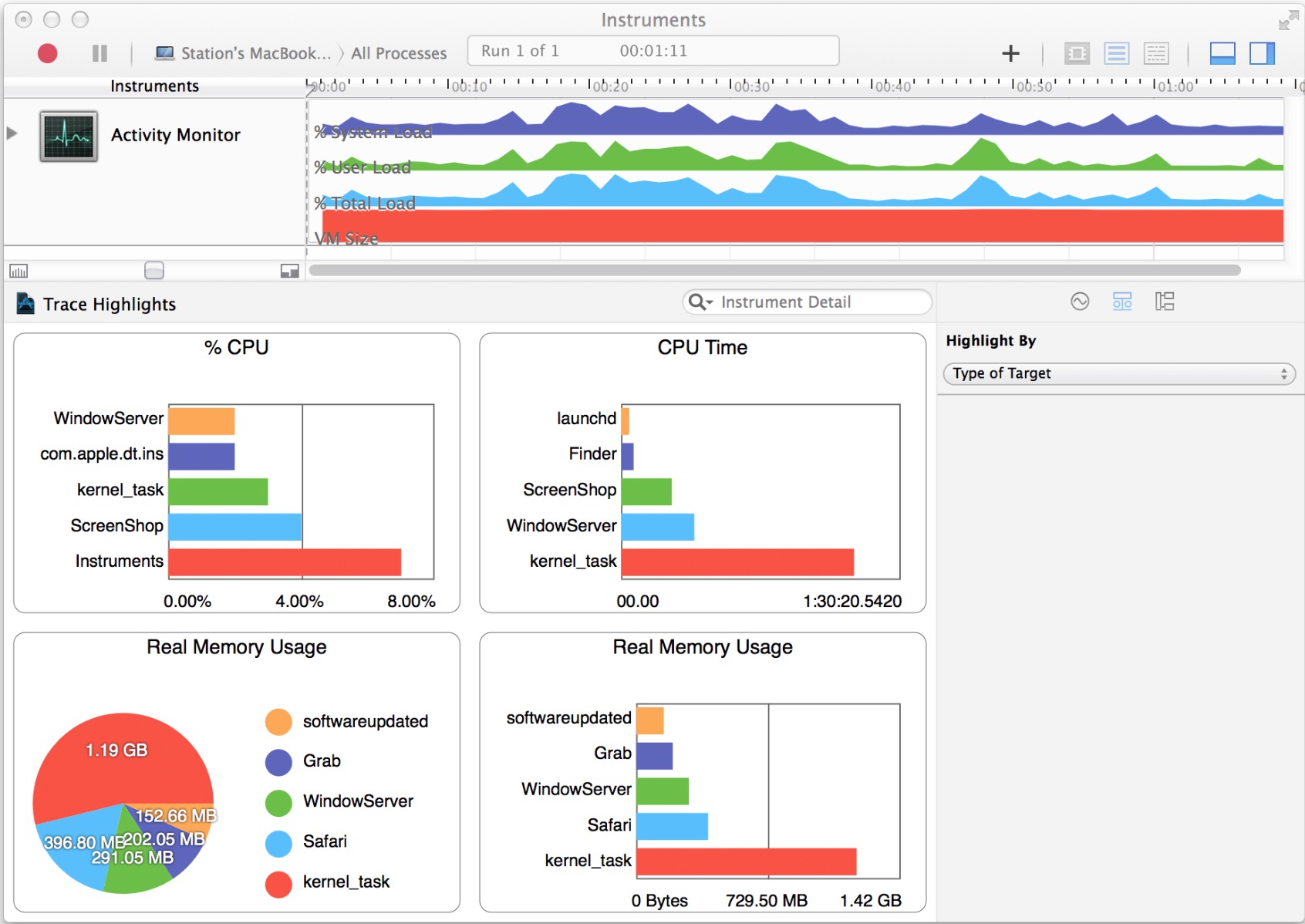
The Record Settings area in the inspector sidebar includes a list of system statistics, which can be configured to appear in the track pane and graphically represent collected data. Select a statistic’s checkbox to see it graphed in the track pane. Click the shape or the color well to change how a statistic appears in the track pane.
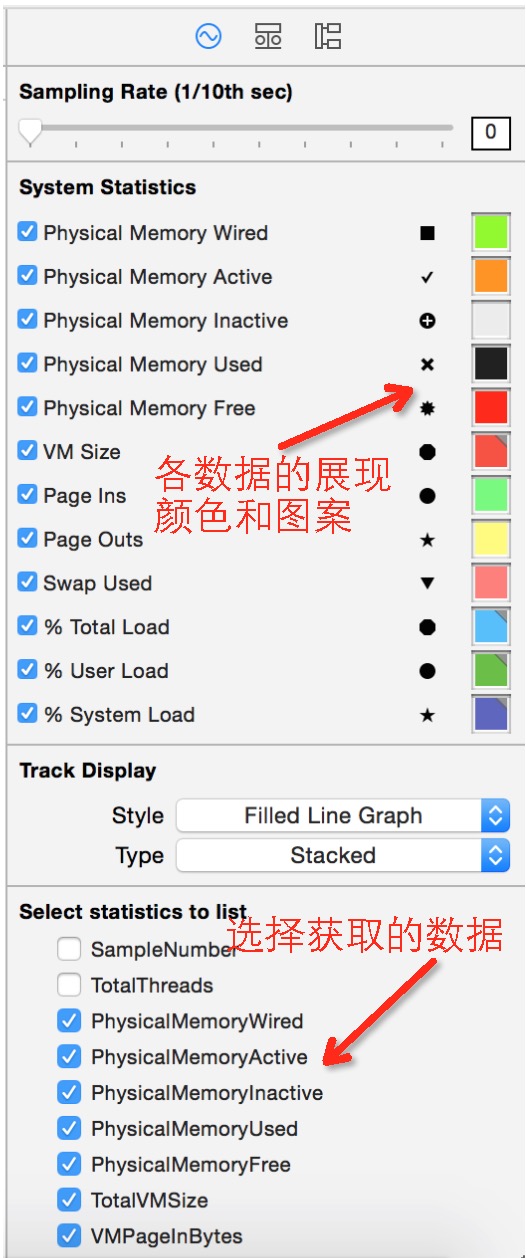
There are a number of statistics the Activity Monitor instrument supports, but the following ones are memory-specific:
Physical Memory Wired
Physical Memory Active
Physical Memory Inactive
Physical Memory Used
Physical Memory Free
Total VM Size
VM Page In Bytes
VM Page Out Bytes
VM Swap Used
If one of the statistics above doesn’t appear under System Statistics, locate it under “Select statistics to list” and click its checkbox to include it in the list.
三、Activity Monitor监控CPU情况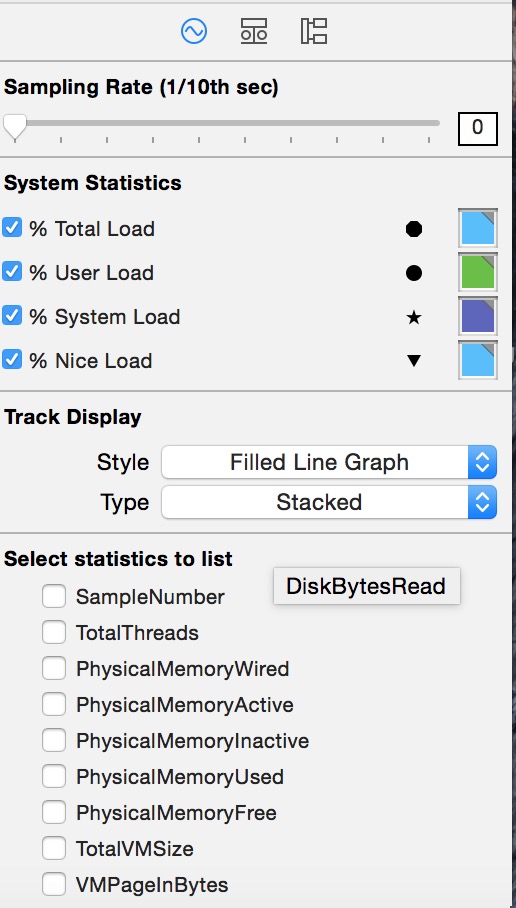 There are a number of statistics the Activity Monitor instrument supports, but the following ones are memory-specific:
There are a number of statistics the Activity Monitor instrument supports, but the following ones are memory-specific:
CPUTtotalLoad
CPUUserLoad
CPUSystemLoad
CPUNiceLoad
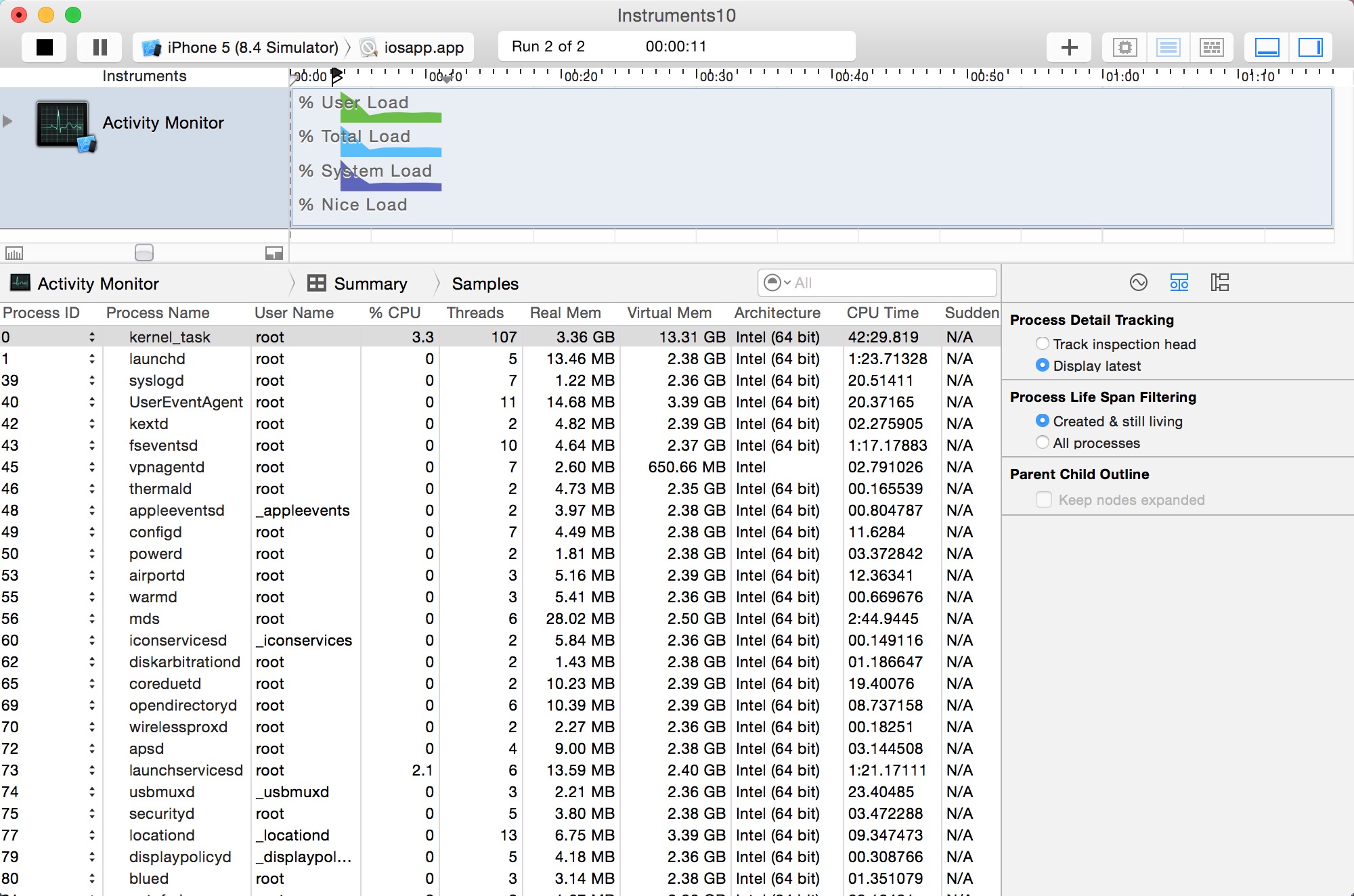 四、Activity Monitor监控网络情况
四、Activity Monitor监控网络情况
By default, the Activity Monitor template isn’t set up to display network activity. Therefore, you need to enable the desired network-related statistics in the Record Settings area in the inspector sidebar for the Activity Monitor instrument to see which processes are sending and receiving information.
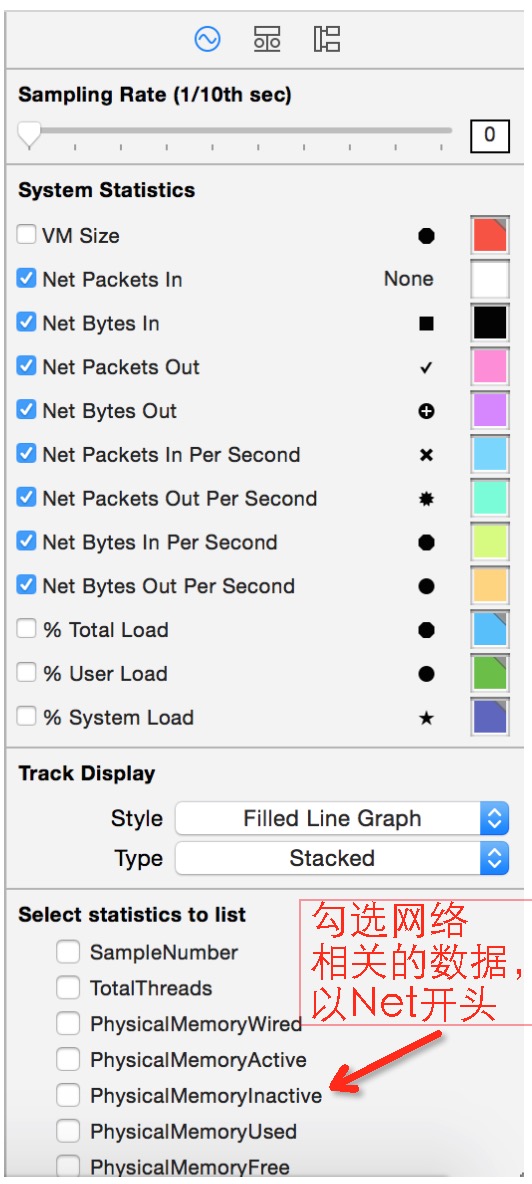
There are a number of statistics the Activity Monitor instrument supports, but the following ones are network-specific:
Net Packets In
Net Bytes In
Net Packets Out
Net Bytes Out
Net Packets In Per Second
Net Packets Out Per Second
Net Bytes In Per Second
Net Bytes Out Per Second
If one of the statistics above doesn’t appear under System Statistics in the Record Settings inspector, locate it under “Select statistics to list” and click its checkbox to include it in the list.
Once you have gathered network activity for your app, examine it carefully to pinpoint areas where your app is sending out excessive amounts of information and therefore tying up valuable device resources. When you minimize the amount of information sent and received, you can benefit from increased performance and response times in your app.
下图为Activity Monitor instrument tracing network packets
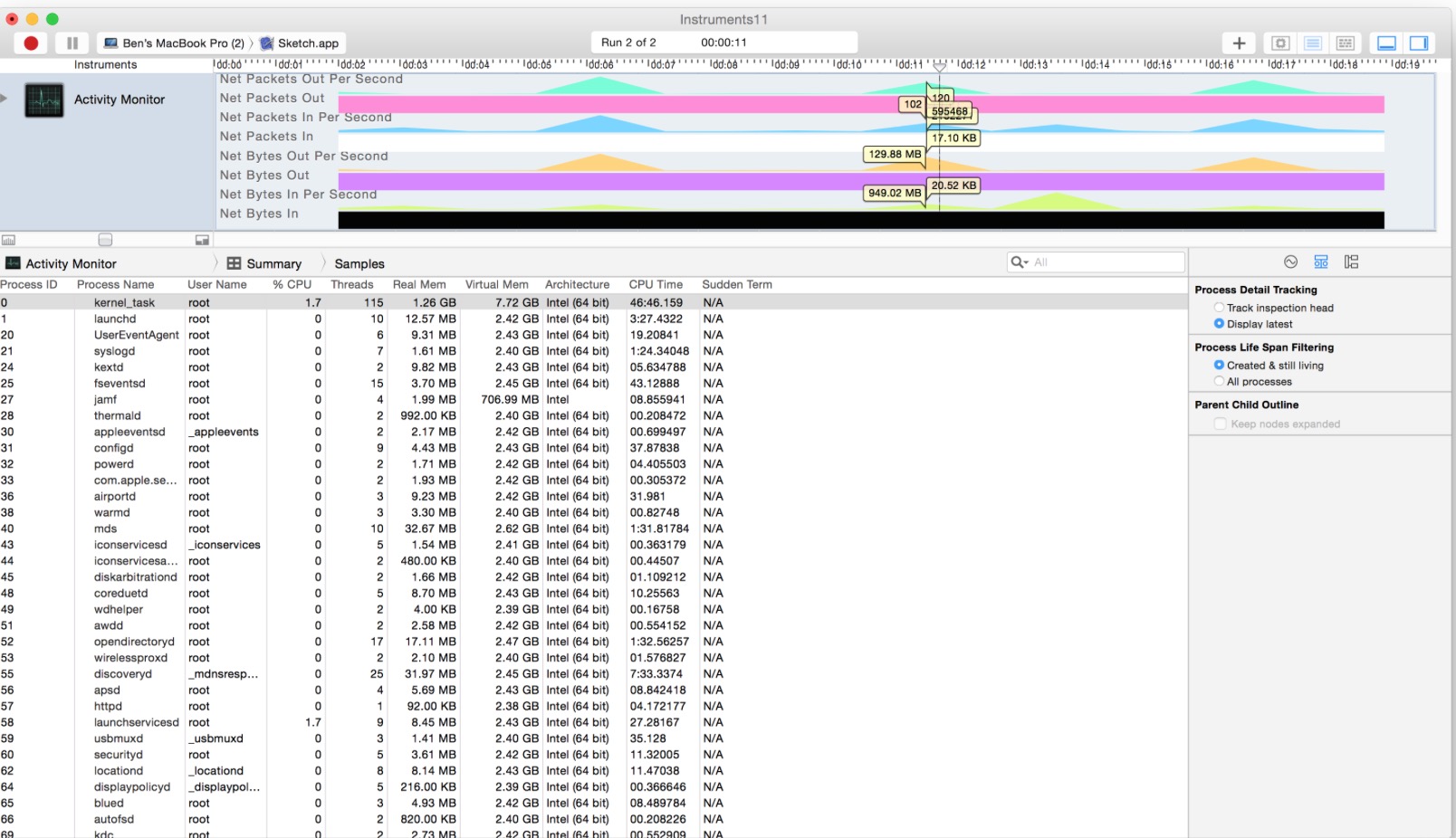
小白学习instrument之Activity Monitor
Monitor Memory Usage Using Activity Monitor
Instruments User Guide
转载请注明出处:http://www.cnblogs.com/JuneWang/p/4789910.html- 上一篇文章: 源码阅读:SDWebImage
- 下一篇文章: 【读书笔记】iOS-引用计数
- 5Transforms转移笔记
- iOS阶段学习第18天笔记(Plist-Archiver-归档
- [好程序员训练营]Objective-C学习笔记-
- 斯坦福iOS7公开课10笔记及演示Demo
- (翻译)开始iOS7中自动布局教程(二)
- 【读书笔记】iOS网络-解析响应负载
- UITableView分隔线